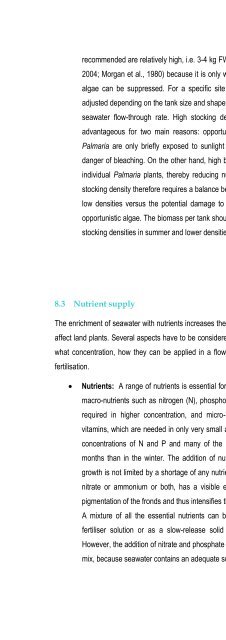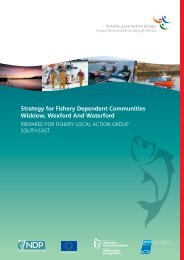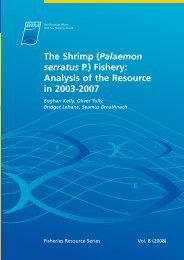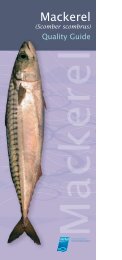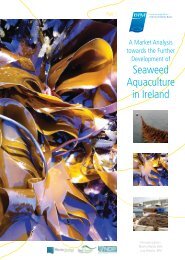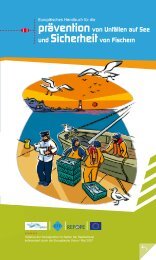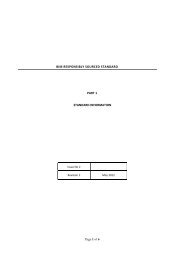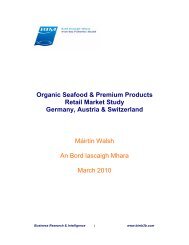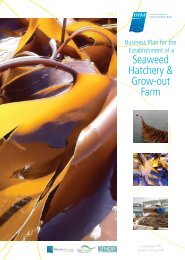Cultivating Palmaria palmata - Bord Iascaigh Mhara
Cultivating Palmaria palmata - Bord Iascaigh Mhara
Cultivating Palmaria palmata - Bord Iascaigh Mhara
Create successful ePaper yourself
Turn your PDF publications into a flip-book with our unique Google optimized e-Paper software.
ecommended are relatively high, i.e. 3-4 kg FW m -2 (Demetropoulos & Langdon, 2004; Pang & Lüning,<br />
2004; Morgan et al., 1980) because it is only with such dense cultures that the growth of opportunistic<br />
algae can be suppressed. For a specific site and tank set-up, however, stocking densities may be<br />
adjusted depending on the tank size and shape, light exposure and season, and nutrient application and<br />
seawater flow-through rate. High stocking densities create more shading in the tank, and this is<br />
advantageous for two main reasons: opportunistic algae are shaded out, and individual blades of<br />
<strong>Palmaria</strong> are only briefly exposed to sunlight when tumbled in the water flow, so that there is less<br />
danger of bleaching. On the other hand, high biomass in the tank reduces the flow along the fronds of<br />
individual <strong>Palmaria</strong> plants, thereby reducing nutrient uptake and in turn reducing growth. Selecting a<br />
stocking density therefore requires a balance between good growth rates stimulated by high nutrients at<br />
low densities versus the potential damage to fronds caused by high light, and the competition from<br />
opportunistic algae. The biomass per tank should certainly be adjusted to the available light, with higher<br />
stocking densities in summer and lower densities in winter.<br />
8.3 Nutrient supply<br />
The enrichment of seawater with nutrients increases the growth of cultured algae in the same way that fertilisers<br />
affect land plants. Several aspects have to be considered about nutrient addition, e.g. which nutrients to add, at<br />
what concentration, how they can be applied in a flow-through system, the potential side effects of seawater<br />
fertilisation.<br />
Nutrients: A range of nutrients is essential for the growth of seaweeds, and these can be divided into<br />
macro-nutrients such as nitrogen (N), phosphorus (P), potassium, calcium and magnesium, which are<br />
required in higher concentration, and micro-nutrients such as cobalt, iron, manganese, zinc and<br />
vitamins, which are needed in only very small amounts. Seawater provides all these nutrients, but the<br />
concentrations of N and P and many of the micro-nutrients will be much lower during the summer<br />
months than in the winter. The addition of nutrients ensures that all nutrients are in excess, so that<br />
growth is not limited by a shortage of any nutrient. The application of N especially, in the form of either<br />
nitrate or ammonium or both, has a visible effect on the appearance of <strong>Palmaria</strong>: it increases the<br />
pigmentation of the fronds and thus intensifies the colour of the tissue to dark purple-red.<br />
A mixture of all the essential nutrients can be applied in the form of self-prepared or ready-mixed<br />
fertiliser solution or as a slow-release solid fertiliser. Some agricultural fertilisers may be useful.<br />
However, the addition of nitrate and phosphate at a 10:1 ratio can be as effective as a complete nutrient<br />
mix, because seawater contains an adequate supply of most of the metals required.<br />
53


